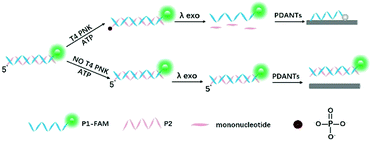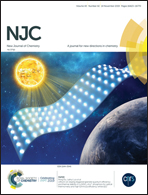A novel fluorescence method for the highly sensitive detection of T4 polynucleotide kinase based on polydopamine nanotubes†
Abstract
Herein, a novel fluorescence method is reported for the detection of T4 polynucleotide kinase (T4 PNK) based on a FRET between dye-labeled DNA and polydopamine nanotubes (PDANTs). PDANTs can bind and quench the fluorescent dye-labeled single-stranded DNA (ssDNA) probes, whereas they have low affinity towards double-stranded DNA (dsDNA). In the presence of T4 PNK and ATP, λ exonuclease initiated the hydrolysis of the 5-phosphoryl termini of dsDNA and released ssDNA, which could strongly adsorb on the PDANTs and decrease the fluorescence intensity; on the basis of this concept, we successfully established a method for the detection of T4 PNK. The method displayed the detection limit of 0.01 U mL−1 with a linear range from 0.01 to 50 U mL−1. In addition, we investigated the effect of several inhibitors including Na2HPO4, (NH4)2SO4 and NaCl. The method provides a platform for the detection of T4 PNK and evaluation of inhibitors.



 Please wait while we load your content...
Please wait while we load your content...